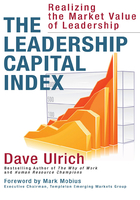
How Do Investors Assess Quality of Leadership?
Some investors focus on financial returns or intangibles (or both) and ignore leadership altogether. Wise long-term investors recognize that leadership matters. A colleague reports working in an energy company whose price/earnings ratio was consistently below industry average. When queried, investors said that the firm was too reliant on one key leader, and they weren’t confident in his health, his willingness to stay at the company if he received a better offer elsewhere, and his ability to build successor candidates. In this case, investors looked at the senior leader’s personal commitment as a surrogate for leadership and discounted the company’s value.
Another firm regularly invites investors to management briefings that go beyond the publicly available financial data or summaries reported by advisory services. This firm also invited significant investors to visit one of its operations and spend a few hours talking to employees in unscripted conversations. These investors got a real sense of the extent to which stated goals were shared throughout the organization, which gave them more confidence in the firm’s future than they would have derived from formal presentations by senior management.
An investor from a large investment fund shared its three-step decision-making process:
 Pick an industry, based on likely growth of a particular market because of demographics, social conditions, or technology.
Pick an industry, based on likely growth of a particular market because of demographics, social conditions, or technology.
 Identify three to five leading firms in the industry, based on the financial returns indicated on income statements and balance sheets.
Identify three to five leading firms in the industry, based on the financial returns indicated on income statements and balance sheets.
 Learn about the leaders of these industry front-runners.
Learn about the leaders of these industry front-runners.
While the firm had sophisticated analytics to test projections of industry growth and to evaluate financial performance, its assessment of leaders was much more subjective. After some discussion, the investor finally said that the favorite ploy was to invite the CEOs of the selected firms into an uncomfortable situation—take them out sailing, for instance, one at a time—to see how they responded. The analysts could then watch how the CEO handled the uncertainty. It was hard not to laugh: sailing as a test of whether or not a leader can make choices that help a company continue to outperform its industry? It seems odd that this successful fund follows a very sophisticated industry and financial analysis by a "finger in the wind” assessment of leadership—but even that has proved useful.
These cases, and countless others, show that many executives recognize the importance of helping investors become more acquainted with and aware of company leaders, and many investors are equally eager for the insight. But they also highlight how frequently the exposure of investors to company leadership is haphazard and episodic, often focused on a few leaders with limited information. The decision-making process resembles shopping for a house on the Internet and making a choice based on pictures, property tax, age, and so forth—without visiting the house to get a feel for the neighborhood, the condition of the house, and the flow of living in it. While few would buy a house that way, investors often buy into a firm without a thorough or thoughtful leadership assessment. When investors define leadership only as the CEO, when they examine only one aspect of effective leadership, or when they assess haphazard views of leadership, they are working in the right direction but with limited information.